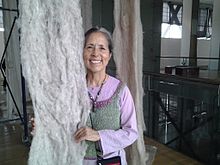Cecilia Vicuña
| Cecilia Vicuña | |
|---|---|
 |
|
| Born |
July 22, 1948 Santiago, Chile |
| Nationality | Chile |
| Citizenship | United States |
| Genre | Poetry |
Cecilia Vicuña (born July 22, 1948) is a Chilean poet, artist, and filmmaker. Her work is noted for themes of language, memory, decay and exile. Critics also note the relevance of her work to the politics ecological destruction, cultural homogenization, and economic disparity, particularly the way in which such phenomena disenfranchise the already powerless.
Vicuña was born and raised in Santiago de Chile in 1948, but went into exile in London in 1973 following the death of President Salvador Allende and the 1973 Chilean coup d'état led by General Augusto Pinochet.
In 1980, Vicuña moved to New York City.
Cecilia Vicuña was part of a group of artists and poets, Tribu No, that created art actions in Santiago de Chile from 1967 to 1972. She gave the group its name and authored its "No Manifesto."
She performs her poetry internationally, frequently in conjunction with exhibitions or art installations, and documents her performances in videos, the Vicuña audio page at Pennsound, and the 2012 collection Spit Temple: The Selected Performances of Cecilia Vicuna which includes transcriptions, commentary, and audience commentaries.
Vicuña has authored and published sixteen books of her visual art installations and poetry books, most of which have been translated into several languages. These include Saboramí (1973), a book made in collaboration with Felipe Ehrenberg that resembles a personal diary,The Precarious/Precario (1983), Cloud Net (2000), Instan (2002) and Spit Temple (2010), a collection of her oral performances. In 2009 she co-edited the Oxford Book of Latin American Poetry with Ernesto Livon Grosman, an anthology of 500 years of Latin American Poetry, which the Washington Post called "magisterial".
Vicuña creates "precarious works;" characteristic of Vicuña's work is her use of materials that are often fragile, worn by the elements and/or biodegradable: the return to the environment. She describes her work as a way of "hearing an ancient silence waiting to be heard." In 1966 she began creating sculptural interventions called precarios, combining ritual and assemblage and typically throw-away materials such as yarn, sticks, feathers, leaves, stones and bones. Linked to the sacred wild Andean vicuña animal by name, Cecilia Vicuña utilized the wool of these animals for her Cloud-Net installation series as a metaphoric tool. The visual language of this series resulted in large-scale warp and weft installations within rural and urban environments—weavings—thus linking Vicuña to the Feminist Art Movement's Pattern and Decoration Movement.
...
Wikipedia
